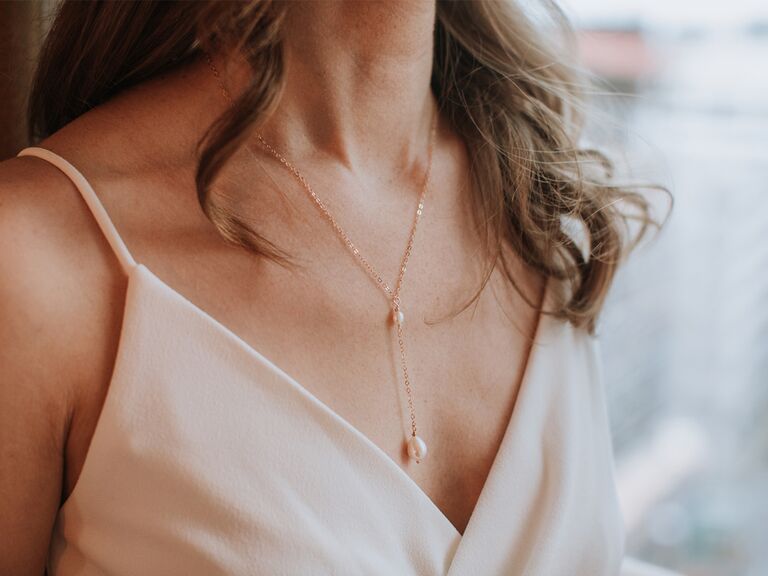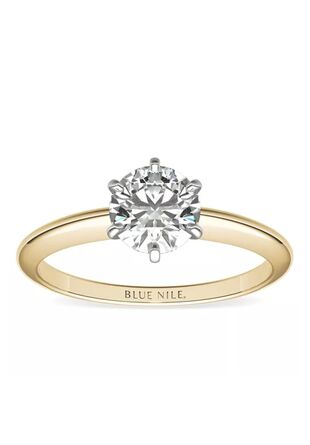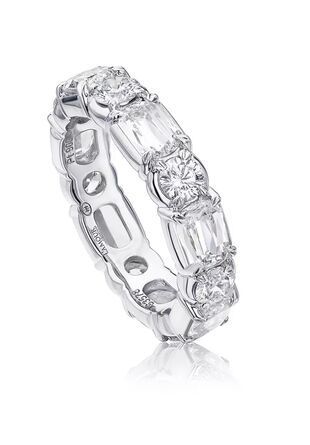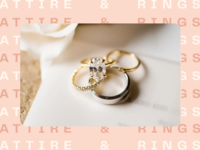Pearls on Your Wedding Day: Beautiful or Bad Luck?

Elegant and understated, the iridescent pearl is making a major comeback in the fashion world right now. So it only makes sense that the pearlcore trend is taking the wedding world by storm, too. But if you're considering adorning yourself in pearl jewelry on your wedding day, you might be wondering, are pearls bad luck for a wedding?
Timeless, elegant and totally wedding ready thanks to their shimmery white finish, pearls seem like an obvious choice for wedding jewelry. In most Western cultures, pearls symbolize purity, innocence and modesty, says Marelle Couture, founder of Hopscotch Couture on Etsy.
But they're also the source of many wedding superstitions. It turns out that cultures all over the world have their own thoughts about pearls, and whether they should be a part of your special day. Here, we'll take a look at some of those meanings so you can decide if you'd like to wear pearls as you walk down the aisle.
- The Meaning of Wearing Pearls, Traditionally
- So What's the Deal: Are Pearls Bad Luck For Brides?
- Can You Wear Pearls to a Wedding, Based on Your Role
The Meaning of Wearing Pearls, Traditionally
Pearls are one of the most popular options when it comes to wedding jewelry and accessories. As you're shopping for your big day, you'll find pearl-encrusted wedding gowns, pearl veils, gloves and of course, plenty of pearl jewelry. But many cultures around the world consider pearls a sign of mourning or even bad luck, while others revere them, reserving them for elite members of society.
Joseph Denaburg, a fourth-generation jeweler at Levy's Fine Jewelry in Birmingham, Alabama says, "different societies across the globe attach unique meanings to pearls. Understanding the various symbolism and cultural significance of this gemstone can help us appreciate its timeless beauty and elegance even more." Let's take a look at some wedding traditions around the world when it comes to the meaning of wearing pearls.
Ancient Greece: Love and Purity
According to Denaburg, "Ancient Greeks believed that pearls were made when Aphrodite shed tears of happiness. The tears symbolize love and purity; hence, they are used widely as bridal ornaments meant to bring about marital joy and peace."
Ancient Rome: Wealth and Social Status
Romans believed the pearl was an indicator of one's wealth and high social status, Denaburg says. "In 1 B.C., Julius Caesar forbade non-aristocrats from wearing pearls, which represented power and status. Queens and other noble ladies put on pearl jewelry, believing that the gems would attract more wealth into their lives."
China: Wisdom and Enlightenment
"In Chinese culture, pearls are associated with wisdom or enlightenment due to the belief that dragons, which are strong immortal beings, carry them in their mouths," Denaburg says. Since they're also believed to have protective properties, pearls are often used in concoctions promoting good health as well as long life, he continues.
Japan: Sorrow and Purity
The Japanese symbolism for pearls is characterized by duality. "According to Japanese folktales, pearls represent the tears and sorrows offered by mermaids and nymphs. Yet, they are also known symbols of innocence and purity," Denaburg says.
Ancient Egypt: Wealth and Power
Among ancient Egyptians, no jewel could compare itself to a pearl in terms of showing off affluence or social standing. Cleopatra famously dissolved one pearl into wine to show off her wealth to Mark Antony because, during these times, pearls were symbolic of divine power, luxury and extravagance.
Persian Mythology: Purity and Perfection
In Persian mythology, pearls were believed to be the gods' tears from heaven. As such, says Denaburg, pearls resembling the moon and water are considered embodiments of purity and perfection.
Moon Associations
Pearls are also associated with the moon, Couture says, which cycles through phases. "This association can suggest the ups and downs in relationships, potentially indicating instability."
So What's the Deal: Are Pearls Bad Luck For Brides?
So, are pearls unlucky on your wedding day? Of course not! While pearls do have some negative connotations throughout history, if you feel comfortable and beautiful wearing them, there's nothing stopping you from doing so. "Pearls complement various bridal styles, from traditional to modern, enhancing the overall bridal look with their understated elegance," Couture says. "The negative connotation comes from some cultures' belief that the round shape of pearls resembles tears, which could bring sorrow or sadness to the marriage. Similarly, in Victorian times, pearls were often associated with mourning when worn by brides, symbolizing sadness or loss."
In modern times, though, these beautiful baubles make a wonderful addition to your wedding day attire, and it's all about feeling and looking your best on your big day.
Can You Wear Pearls to a Wedding, Based on Your Role
In keeping with that, you may be wondering, can you wear pearls to a wedding? Know that it's fine to wear pearls to a wedding, whether you're the bride or part of the wedding party or even a guest. "Pearls are a classy option for mothers of the bride, bridesmaids or guests at weddings because their timeless beauty and elegance are versatile enough to match any look or wedding motif," says Couture.
And it's even okay to give pearls as a wedding gift. But, if you choose to do so, always take into account the couple's cultural backgrounds and traditions to ensure that wearing pearl jewelry doesn't go against their beliefs or customs, Denaburg advises.
Can guests wear pearls to a wedding?
As a guest at a wedding, you want to look your best, no matter what dress code the couple has specified. As you think about what to wear to a wedding, know that it's completely fine to wear pearls to a wedding when you're a guest, especially if you have a meaningful piece of pearl jewelry that you wear often. "Pearls are a timeless and elegant choice for wedding guests," Couture says, as they're timeless and elegant, adding a touch of sophistication to any outfit.
Unless the couple has specifically stated they'd prefer guests to avoid pearls, or you have first-hand knowledge that one or both partners is particularly averse to pearls (in which case they should be considered as what not to wear to a wedding), it's okay to wear pearls at a wedding.
Can the mother-of-the-bride wear pearls?
Even if you're the mother of the bride, it's acceptable to wear pearls on a wedding day.
Says Couture, "Pearls are an excellent choice for mother-of-the-bride jewelry, conveying sophistication and elegance. They complement most formal or semi-formal attire worn by the mother-of-the-bride, adding a touch of refinement to her ensemble." Again, unless your daughter and/or her partner have specifically asked you not to wear pearls, or you happen to know one of them is vehemently against it, pearls make a beautiful accessory for a mother-of-the-bride dress.
Can I wear pearls to the wedding as a bridesmaid?
If you're planning your jewelry for your role as a bridesmaid, you might wonder if you can wear pearls in a wedding. The answer is yes! Unless the bride has given you bridesmaid jewelry as a gift that she'd like you to wear (like a bracelet or bridesmaid earrings), or specifically stated what sort of jewelry you should wear (within reason), it's okay to wear pearls in a wedding as part of the wedding party.
Of course, if the bride has specifically asked you to avoid pearls, or you know she's feeling unsure or questioning, are pearls bad luck for a wedding, you should steer clear of pearl jewelry out of respect for her. But if, for example, you have a piece of pearl jewelry you wear every day, like a pearl engagement ring, it's fine to keep it on for the wedding.
Is it bad luck to give the couple pearls for their wedding?
Giving pearl gifts for a wedding can be a thoughtful gesture symbolizing purity and longevity in the relationship, says Couture. But before you do so, it's essential to consider the couple's cultural beliefs or superstitions regarding pearls before gifting them, as some may view pearls differently based on their traditions or customs. If you're unsure about the couples' beliefs about if pearls are bad luck, you can simply ask. After all, it's better to be safe than sorry!
























